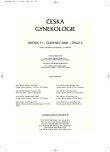Intrapartal Fetal Monitoring, Sensitivity and Specificity of Methods
Authors:
Z. Hájek 1; B. Srp 1; M. Pavlikova 2; J. Zvárová 2; K. Liška 1; R. El Haddad 1; A. Pašková 1; A. Pařízek 1
Authors‘ workplace:
Gynekologicko-porodnická klinika 1. LF UK a VFN, Praha, přednosta prof. MUDr. A. Martan, DrSc.
1; EuroMise centrum, Ústav informatiky AV ČR, Praha, ředitelka prof. RNDr. J. Zvárová, DrSc.
2
Published in:
Ceska Gynekol 2006; 71(4): 263-267
Category:
Original Article
Overview
Objective:
To evaluated sensitivity and specificity of presently used methods for intrapartal monitoring (CTG, FpO2 a STAN S-21) and their mutual comparison.
Type of study:
A prospective study.
Setting:
Gynecological–Obstetrical Clinic, 1st Medical Faculty, Charles University and general Teaching Hospital, Prague.
Method:
In 114 pregnant women with high-risk or pathological course of pregnancy the authors evaluated the capability of individual methods to predict intrapartal hypoxia, determined on the basis of postnatal evaluation of parameters observed (Apgar score in 1st minute, pH from umbilical artery, lactate levels in fetal blood, base excess (BE) and postpartum condition of fetus evaluated by a neonatologist). Each method was categorized according to its importance. The quality of individual methods was evaluated by means of their sensitivity and specificity as well as by the area under ROC (Receiver Operating Characteristic), i.e. AUC (Area under Curve). A similar or different prediction of the condition of the newborn by these individual methods was evaluated by the McNamara test of symmetry. In 50 deliveries performed by Cesarean section and 24 forceps deliveries the authors evaluated postnatal pH from umbilical artery and evaluation by Chi-square test. The women in childbed were infused with a tocolytic drug (hexoprenalin) before Cesarean section. All tests were performed at 5% level of significance.
Results:
Low level of Apgar score in the 1st minute and less) always indicated CTG, but also a large proportion of normal newborns. STAN, in contrast, well indicates all newborns with a normal point evaluation. The best balanced evaluation of the newborns is provided by FpO2 and there was a significant difference between CTG and FpO2. In evaluating pH from the umbilical artery (pH < 7.20), TCG proved to be most sensitive again but displayed low specificity. STAN was the best predictor of newborns with normal pH. In evaluating high levels of lactate (> 3.7mmol/L) and BE (> - 10) and related demonstration of metabolic acidosis STAN proved to be the best predictor. The condition of the newborn evaluated by a neonatologist immediately after birth (medium or heavy depression) was best predicted by FpO2. In deliveries performed by Cesarean section and after the administration of tocolysis the postnatal pH was higher then in forceps deliveries without acute tocolysis. The occurrence of emergencies in the course of a pathological delivery in individual methods is as follows: CTG, FpO2 and STAN.
Conclusion:
Even though CTG displays a very low specificity, this method should not be rejected, since it draws attention of the obstetrician very early to the possibility of developing hypoxia. FpO2 or STAN gives more precision to the situation and demarcates a correct moment for ending the delivery for the indication of fetus hypoxia intra partum. STAN is the best predictor for conditions of developing metabolic acidosis, evaluated postnatally by the level of lactate and BE in fetal blood.
Key words:
sensitivity, specificity, hypoxia diagnosis, cardiotoxicography, fetal pulse oximetry, ST-analysis of fetus ECG
Labels
Paediatric gynaecology Gynaecology and obstetrics Reproduction medicineArticle was published in
Czech Gynaecology

2006 Issue 4
Most read in this issue
- Etiopathogenesis of the Prolapsed Vaginal Vault after Hysterectomy
- Actual Management of Pregnancies at Risk for Fetal Anemia
- Harmatoma of the Breast – Case Report
- Gynecological Aspects of Thyroid Disorders. A Review
